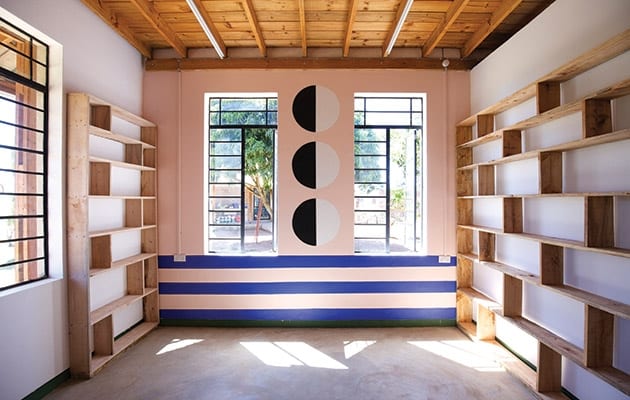 The library had been renovated before Walala added her designs. Photos by: Harry Freeeland|||
The library had been renovated before Walala added her designs. Photos by: Harry Freeeland|||
On a Tanzanian island, far, far away, there is a vibrant building. In this building, there is a diverse community. And among this community, there is a level of creativity and passion that transcends colour. But it wasn’t always that way.
Deep in the heart of Tanzania’s Lake Victoria, the Ukerewe Island has a long history of discrimination against people with albinism. Over the years, these people have been ostracised, abused and abandoned, all the while being at high risk of skin cancer due to their condition.
 Julia Jomaa and Camille Walala at the Umoja Training Centre
Julia Jomaa and Camille Walala at the Umoja Training Centre
Since 2012, Standing Voice – an international NGO with a mission to end human rights’ abuses against marginalised groups – has been working towards bridging this divide and building a platform to unify a fragmented community. As a result, the organisation, spearheaded by filmmaker Harry Freeland whose 2012 documentary “In the Shadow of the Sun” catalysed a wave of interest in the issue, has built the Umoja Training Centre (UTC), an inclusive community training facility providing skills development and economic enrichment to people with and without albinism.
This summer, celebrated artist Camille Walala and her creative director Julia Jomaa brought their patterned trademark to Ukerewe, just in time for the centre’s second Summer Skills Workshop, which saw 85 participants engage in creative workshops over a period of two weeks. “It took us a long time to get there. Three planes, one boat – and so I only had five days,” says Walala, who happens to be travelling as we speak.
Over the span of that month, the artist visited four continents, “from a crazy casino in China to the middle of Tanzania on a small island”, prompting her to think ahead of time. “I did some designs, worked with the colours looking at pictures of Tanzania. I also did some prints for charity; that was how we got the funding to go there.”
 Vibrant colours adorn the water tanks
Vibrant colours adorn the water tanks
Walala draws a lot of her inspiration from architecture. “Everything around me is patterned. I take pictures of pipes on windows; I see stripy floors created from different textures. When I’m lacking inspiration I take a step back and look around by travelling, going to see exhibitions,” she says. Interestingly, Walala also draws inspiration from another African tribe called Ndebele, whose patterns are designed to convey feelings and emotions.
In Ukerewe, the artist’s patterns seem endowed with the same power. “I wanted to do something that they can be proud of,” she says. “People might struggle on an everyday basis, but it was nice to do something where you give them love and interest.” And so, she spent five days dressing the UTC with patterns – from the library, to the water tanks and external facades – injecting it with a vibrant backdrop for workshops and activities.
Before Walala left her mark, the training centre had been refurbished by UK-based, designer-fabricator Simon Sawyer, who worked with artist Alex Booker and local carpenter Lusato Mkeka to renovate the centre’s community library.
Harry Freeland explains how the architecture of the building has elevated the albinism association’s status on the island and across the country. “These building are renowned on Ukerewe Island,” he says. “What Camille’s designs have added is yet another layer of originality, personality and vibrancy to a place that is buzzing and growing in confidence each day.”
 The training centre facades are brightened with a repeated pattern
The training centre facades are brightened with a repeated pattern
Aptly named – with Umoja being the Swahili word for “unity” – the Umoja Training Centre was designed to help encourage inclusion. As Freeland explains: “The centre and its grounds cater for the specific needs of people with albinism (PWA). The buildings are positioned to minimise exposure to sunlight, creating a tranquil and shaded environment for PWA and their visitors. The gardens’ many trees afford additional cover from the sun. The centre itself has high ceilings and broad overhangs, with ample shade to guard against UV radiation.”
Coupled with wheelchair ramps and gutters that lead to water tanks, which harvest up to 180,000 litres of rainwater, the UTC might not have been ascribed an official “green” certificate, but it is certainly worthy of a similar accolade.
There is “a wonderful sense of community ownership” and pride in the building of this centre, which involved the whole community. And to borrow Freeland’s words: “For them to see it now, emblazoned with Camille’s signature designs, it has made them even more proud of their home.”
Camille Walala’s trademark vibrant designs are boosting a training facility in Tanzania that supports persecuted people with albinism






















